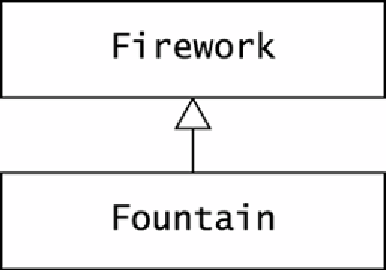Java Reference
In-Depth Information
Figure 14.1. In certain conditions, Java will provide default constructors and default
constructor collaboration.
A problem arises if we add a constructor to the superclass. Suppose that we add a
name
attribute to
Firework
and a constructor that accepts it:
public Firework(String name)
{
this.name = name;
}
After this change to
Firework
, the
Fountain
class will suddenly fail to compile. The
Fountain
class defines no constructor, so Java will supply a default constructor. This
constructor makes a default call to
super()
, the superclass's default constructor. However,
this constructor no longer exists. Java supplies a default constructor only if the class has no
other constructor. By creating a constructor for
Firework
, we eliminate this class's default
constructor and thereby break the
Fountain
class.
CHALLENGE 14.2
Write a constructor for the
Fountain
class that allows it to successfully compile.
Java will not always insert a call to
super()
in a constructor. A constructor can avoid this
default behavior by explicitly invoking a superclass constructor or by invoking another
constructor of the current class with a call to
this()
. When a class has several constructors,
they usually apply calls to
this()
to collaborate with one another.
Collaboration within a Class
The constructors of a well-designed class usually interact. Consider what happens when we
need to add a classification attribute to the
Firework
class so that each firework is classified
as a consumer firework or as a display-type firework. Figure 14.2 shows the
Firework
class
picking up firework classification constants from the
ClassificationConstants
interface and adding a
Classification
attribute.





